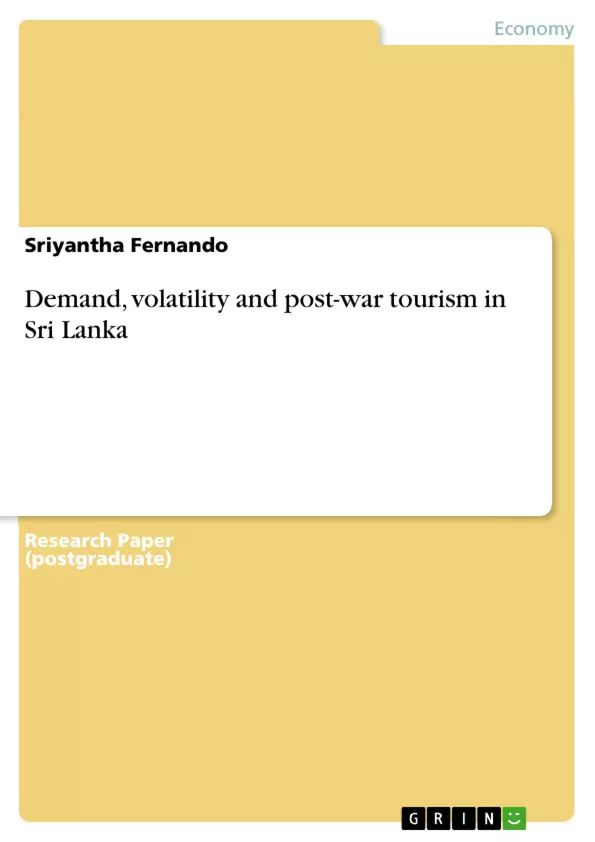Historically Sri Lanka has always been a tourist destination for centuries because of its strategic location and uniqueness. Although Sri Lankan tourism sector has been growing since 1967, International tourist arrivals to Sri Lanka have experienced notable fluctuations during the nearly three decades of civil war, particularly between 1983 and 2009. Sri Lankan tourism has managed to recover quickly since the end of the war in 2009. After recognising the role of post-war tourism, the Sri Lankan government has launched the Tourism Development Strategies for the period 2011-2016. Firstly, The paper carried out systematic statistical analysis for Sri Lankan tourism focussing in particular on the civil war and associated political violence. Secondly, the paper empirically explored whether the targets set in the TDS by the Sri Lankan government are achievable or realistic by using a simple econometric model. Furthermore, post-war tourism development and the tourism boom are being evaluated within the context of the current political and economic situation. The empirical results of the first study demonstrating that the Sri Lankan tourism industry is very sensitive to political violence, exchange rate changes, and seasonal variations. The analysis suggests that significant increases in political violence lowered tourist arrivals in Sri Lanka and created a substantial amount of volatility in tourism demand. The results of the second study indicate that the Sri Lankan tourism industry was in a favorable position to achieve the targets until 2014 but missing the targets in 2015 and it is a challenge to achieve of 2.5 million tourism arrivals by 2016. A number of policy inferences can be drawn from this study. Given the limited resources available to the Sri Lankan government and the competing claims on these resources, development of strategies for and active promotion of public-private partnerships aimed at creating new tourism related infrastructure (hotel resorts, cruise line facilities, road transport upgrades, etc.) are recommended. There is should be a consideration for promoting the country as a price competitive and safe tourism destination. Finally, the country has to maintain political stability and work towards reconciliation process with improved governance and maintaining rules of law in order for the development strategy to be fully realized.
Inhaltsverzeichnis (Table of Contents)
- Introduction
- Risks of Political Violence and Tourism Industry in Sri Lanka
- Empirical Model for the Volatility of Tourism Demand in Sri Lanka
- Methodology
- Model Specification
- Results
- Post-war Tourism Demand and Forecasting in Sri Lanka
- Empirical Model for Tourism Demand
- Evaluation of the Targets
- Issues in tourism Sector in Sri Lanka
Zielsetzung und Themenschwerpunkte (Objectives and Key Themes)
This study aims to systematically analyze the Sri Lankan tourism industry, focusing on the impact of civil war and related political violence, and to evaluate post-war tourism development and the tourism boom within the context of the current political and economic situation. The study also uses econometric models to assess the sensitivity of Sri Lankan tourism to political violence and to evaluate post-war tourism targets.
- The impact of political violence on tourism demand in Sri Lanka
- The volatility of tourism demand in Sri Lanka
- Post-war tourism development and the tourism boom in Sri Lanka
- The evaluation of tourism targets set by the Sri Lankan government
- Policy recommendations for the development of the Sri Lankan tourism industry
Zusammenfassung der Kapitel (Chapter Summaries)
- Introduction: This chapter provides an overview of the Sri Lankan tourism industry, highlighting its historical significance and the impact of the civil war on tourist arrivals. The study's objectives and methodology are also presented.
- Risks of Political Violence and Tourism Industry in Sri Lanka: This chapter examines the relationship between tourism and political violence, exploring how war, terrorism, and political instability can deter international tourists. The chapter also discusses the importance of creating a peaceful environment for tourism development.
- Empirical Model for the Volatility of Tourism Demand in Sri Lanka: This chapter presents an econometric model designed to analyze the volatility of tourist arrivals in Sri Lanka. The model considers factors such as political violence, exchange rate changes, and seasonal variations.
- Post-war Tourism Demand and Forecasting in Sri Lanka: This chapter focuses on post-war tourism development and the tourism boom in Sri Lanka. It presents an empirical model for tourism demand and evaluates the targets set by the Sri Lankan government for tourism growth.
- Issues in tourism Sector in Sri Lanka: This chapter discusses specific challenges facing the Sri Lankan tourism sector, including infrastructure development, price competitiveness, and maintaining political stability.
Schlüsselwörter (Keywords)
This study focuses on the Sri Lankan tourism industry, exploring the impact of political violence, the volatility of tourist demand, post-war tourism development, and the evaluation of tourism targets. Key concepts include econometric modeling, tourism demand, political stability, and public-private partnerships.
- Citar trabajo
- Dr. Sriyantha Fernando (Autor), 2016, Demand, volatility and post-war tourism in Sri Lanka, Múnich, GRIN Verlag, https://www.grin.com/document/370703



